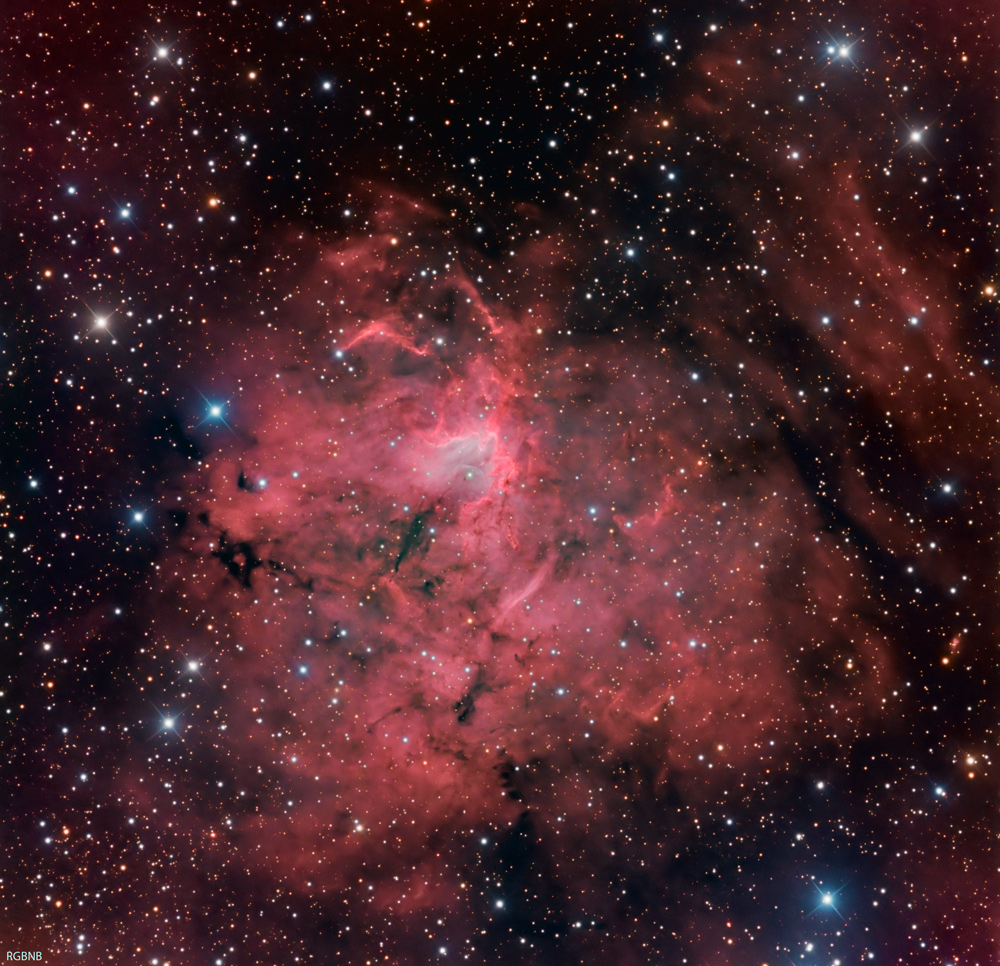HOME
NGC 1491
NGC 1491
Sh2-206
Emission Nebula in Perseus
Click here for higher-resolution versions: 40% (1558x1414) 65%
(2532x2298) 100% (3896x3536)
 Click on image to cycle through the five versions of the image (described below)
Click on image to cycle through the five versions of the image (described below)
NGC 1491 is a bright emission nebula visually located in the constellation Perseus. It is predominantly red in the true-color version, because (i) ionized hydrogen emits in the
red part of the spectrum; (ii) the vast majority of the light matter in the universe is hydrogen, and (iii) the hydrogen in this image is being ionized (stripped of its electron) by a highly-energetic
young star near the middle of the brightest part of the nebula.
The field is thought to be about 11,000 light years from Earth; at that distance, the brighter part of the nebula would be about 100 light years across. Visually, this field is about the width of a full moon
(although very dim by comparison).
I have presented this object in five different formats; I like each one in its own way. This is the order in which they appear as you cycle through (by repeatedly clicking on the photo, waiting for
each to download; each is labeled in the lower left corner), starting with the reddish version (the third and fourth share the same luminance--detail--layer):
(i) A true-color version (the top photo in the stack), with the color created by imaging through red, green and blue filters (with a significant amount of Ha and OIII
data blended into various channels, in varying percentages; Ha emissions are in the red spectrum, and OIII emissions are blue-green, so I have blended Ha into the luminance layer and the red channel,
and OIII into the green and blue channels).
(ii) A true-color version (the second photo in the stack), with the color created by imaging through red, green and blue filters only (no Ha or OIII data included). It is
interesting to see how much the addition of the Ha and OIII increases the impact.
(iii) Since Ha is in the heart of the red part of the spectrum, and OIII is on the border of green and blue, people often create an image only using Ha and OIII, by using the Ha
the red, and OIII as both blue and green (so the shorthand name is "HOO"). That is what I have done here, except I have over-emphasized the OIII (relative to the Ha), resulting in the ghostly, slightly
bluish, center (otherwise it would have been far redder). It's interesting how close this comes to the full "true color with Ha and OIII" version, with considerably less data/imaging time.
(iv) A version in the Hubble palette (a lot of the Hubble photos, including and especially the famous "Pillars of Creation," are made with this set of filters, since
it's a useful set for scientists to see what's actually happening), which shows SII emissions as red, Ha emissions as green, and OIII emissions as blue (with the green from the Ha emissions
de-emphasized in this rendition because it would be so dominant otherwise). I like the clear blue when a nebula has significant oxygen emissions, as is the case here. This form of combining
results in magenta-colored stars, which I have significantly desaturated.
(v) A grayscale version (the last photo in the stack), showing only the Ha emissions. HA-only images are pleasing, to me, for how they show detail and contrast.
Technical Information:
Ha:OIII:SII:L:R:G:B: 720:600:630:741:255:180:240 (a total of over 56 hours of light-frame exposure time); luminance was a blend of 15-minute individual exposures and 3-minute individual exposures;
red and green exposures were all 15-minute exposures; blue all 20-minute exposures; Ha, SII and OIII were all 30-minute exposures. The luminance layer is a blend of the images taken through the luminance filter and the
images taken through the Ha filter. The red channel is a blend of the red-filtered data and the Ha-filtered data. The green channel is a blend of the green-filtered data and the OIII-filtered data. The blue channel is
a blend of the blue-filtered data and the OIII-filtered data.
Equipment: RC Optical Systems 14.5 inch Ritchey-Chrétien carbon fiber truss telescope, with ion-milled optics and RCOS field flattener, at about f/9, and an SBIG STX-16803 camera with
internal filter wheel (SBIG filter set), guided by an SBIG AO-X, all riding on a Bisque Paramount ME German Equatorial Mount.
Image Acquisition/Camera Control: Maxim DL, controlled with ACP Expert/Scheduler, working in concert with TheSky X.
Processing: All images calibrated (darks, bias and sky flats), aligned, combined and cropped in Pixinsight. Color combine in Pixinsight. Some finish work (background neutralization,
color calibration, deconvolution of the luminance data using Russ Croman's BlurXterminator, HDR combine of the luminance data; HDR multiscale transform to reduce the dynamic range; multiscale linear transformation
for sharpening, and noise reduction) done in Pixinsight; some cleanup finish work was done in Photoshop CC.
Location: Data acquired remotely from Sierra Remote Observatories, Auberry, California, USA.
Date: Images taken on many nights in September, October and November of 2022. Image posted December 31, 2022.
Date: Image scale of full-resolution image: 0.56 arcseconds per pixel.
Seeing: Variable.
CCD Chip temperature: -25C
Copyright 2022 Mark de Regt
